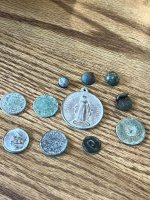ThTx
Hero Member
- Dec 19, 2006
- 855
- 83
- Detector(s) used
- Garrett AT Pro, Garrett Master Hunter CX Plus, Teknetics G2
- Primary Interest:
- All Treasure Hunting
I am new to the sport and have read references to using a test garden to help learn your detector. Does anyone have specific plans or ideas for constructing one? 

Upvote
0







